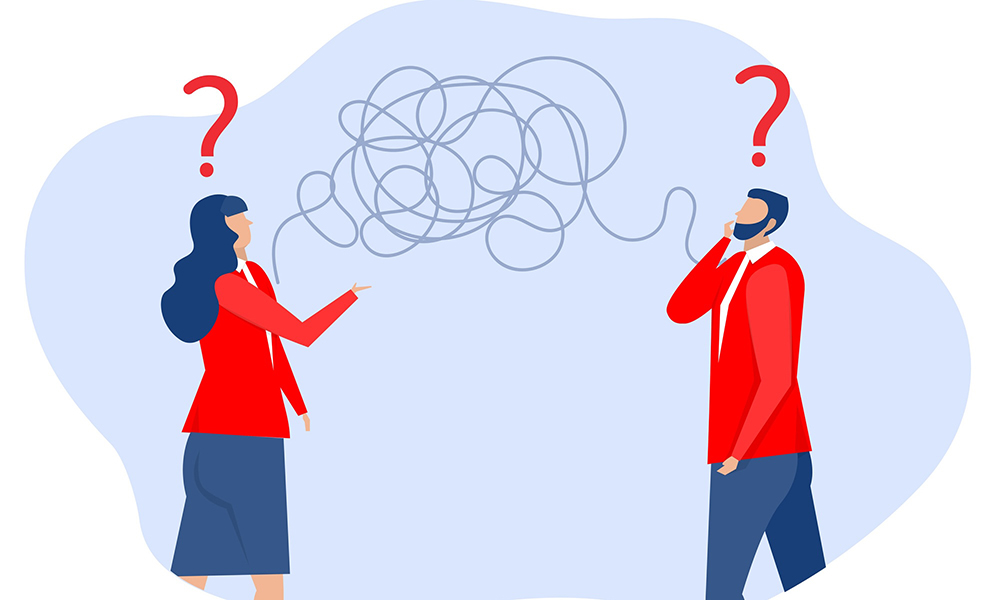You know that uncomfortable feeling you get when you’re delivering a presentation or speaking in a meeting and you see people checking emails or looking at the time or just seeming bored? Sometimes it makes you try harder to get their attention (without much success). Often, you end up quite frustrated with how easily they seem distracted.
There’s no denying that attention spans are waning. The attention span of the average human being is down to eight seconds now, from 12, according to a recent study (that places us even below the notoriously unfocussed goldfish, who notch up nine.)
But what if that isn’t the only reason? Have you ever stopped to wonder if the reason why people seem disengaged is that you’re just taking up too much air time?
So, my message this week is on why you should figure out if you’re talking too much, and what you can do to be more concise and impactful.
The stages of talking to people
According to business psychiatrist and author of Just Listen, Mark Goulston, in his Harvard Business Review article, How to Know If You Talk Too Much, there are three stages that you (unconsciously) follow while talking to other people:
“In the first stage, you’re on task, relevant and concise. But then you unconsciously discover that the more you talk, the more you feel relief. Ahh, so wonderful and tension-relieving for you… but not so much fun for the receiver. This is the second stage – when it feels so good to talk, you don’t even notice the other person is not listening.
The third stage occurs after you have lost track of what you were saying and begin to realize you might need to reel the other person back in. If during the third stage of this monologue poorly disguised as a conversation you unconsciously sense that the other person is getting a bit fidgety, guess what happens then? Unfortunately, rather than finding a way to reengage your innocent victim through having them talk and then listening to them, instead the usual impulse is to talk even more in an effort to regain their interest.”
Does this sound familiar? If it does, you’re certainly not alone. But here’s where it starts getting more interesting. Science pegs the human brain’s capacity to absorb words at 750 per minute. The average person speaks about 150 words a minute. So, there are some 600 odd words that your listeners are probably filling in. So it’s easy for them to tune out. They’re almost programmed to do so.
Most of what you talk about is – you!
It’s not just about talking too much. It’s also about what you end up talking about. Lydia Dishman, in her article The Science Of Why We Talk Too Much (And How To Shut Up), points out that the real concern is that most of what we (like to) talk about, is ourselves.
She references studies that show that people spend 60 per cent of conversations talking about themselves. This goes up to 80 per cent when on social media. That’s a lot of talking! Dishman also points out that Harvard psychologists have even found that people were willing to give up money for the opportunity to disclose information about themselves.
Why do we like talking about ourselves so much? The reasons are deeply linked to who we are, as Goulston points out. Human beings love talking because they crave being listened to. Add to that the fact that studies show that the act of talking releases the pleasure hormone, dopamine, and you have a winning combination.
How to cut down what you’re saying
Before you go any further, introspect a bit about why you’re even talking as much as you are. Is it the dopamine kicking in? Do you just want to keep talking because it feels good to have someone hear you out? Is this cathartic? Are you trying to pack in as much as you can? Does it come from the need to justify yourself? Are you trying to keep the other people engaged? Or is it that you aren’t really prepared for the conversation? Knowing the reason makes it much easier to solve for.
If you’re trying to work on being more concise, here are six suggestions that could be helpful:
1. Be clear about your message
Think through exactly what you want to convey. That will make it easier to keep yourself in check. You will also be able to measure effectiveness more easily.
2. Prepare
When you’re under prepared, you ramble. You’re thinking on your feet and making up the conversation as you go along. So, work on your messaging. Plan how you would like to structure your conversation, what you would like to focus on and what your key takeaways would be. Sometimes, rehearsing the larger pieces is a good idea.
3. Follow the Traffic Light Rule
Goulston suggests following the Traffic Light Rule:
“In the first 20 seconds of talking, your light is green: your listener is liking you, as long as your statement is relevant to the conversation and hopefully in service of the other person. But unless you are an extremely gifted raconteur, people who talk for more than roughly half minute at a time are boring and often perceived as too chatty. The light turns yellow for the next 20 seconds — now the risk is increasing that the other person is beginning to lose interest or think you’re long-winded. At the 40-second mark, your light is red. Yes, there’s an occasional time you want to run that red light and keep talking, but the vast majority of the time, you’d better stop or you’re in danger.”
Try using this to map out your next conversation.
4. Don’t get distracted
Often, we start conversations on a topic. Then, one thing leads another and before you know it, it ends up taking a whole other course. Stay focused. If you find yourself (or the other person) wavering, pull back.
5. Share bite-sized information
More often than not, how much we share ends up being how much we want to share. It isn’t necessarily how much the other person needs to hear. This is rather fundamental shift, but it works really well. Make it bite sized. The easier this is to consume, the more ready the other person will be to ask for the next helping.
6. Tell TED like stories
One of the tips that Joseph McCormack, in his book Brief: Make a Bigger Impact by Saying Less, shares, is to learn from the TED format of storytelling. He quotes Emily McManus, editor of TED’s website saying:
“By 5 minutes in, you need to get into the middle arc of your story. The best thing you can do if you’re trying to compress is not try to tell the entire story of your entire field in 15 minutes. Rather, you want to give an intriguing single story. The best speakers are the ones whose story has a beginning, a middle, and an end, but starts in the middle. People who talk about very specialized subjects need the ability to give an overview of a field in a few minutes. They lay out some of the hard problems and then focus on one specific aspect of that problem.”
7. Draw the other person in
Ideal conversations are balanced, with equal participation by both people. That means you should be cutting down how much you’re saying by roughly half of what it is. Use that time to get the other person to share. Make it more interactive. Ask more questions. Pause to check if people are following you.
I’m sure you can all relate to someone or the other who you think just talks too much. But there’s a very good chance that we are all probably doing this. It’s a tricky habit to work around. So, find someone you trust and ask them if you’re really talking too much. And if you are, then give some of these tips a try.








This was a great read. Its a common thing many of us indulge in. I liked the red, yellow, green light example. Need to be mindful. Thanks.
The concept of story telling from TED show is really interesting and it help lots